
I’ve been spending time in the wetlands again this year, marveling at all the abundant and varied life that can be found here. Though I haven’t met all the residents I’ve seen more than a few and I’ve heard about others from the other nature lovers who come here. I took this shot of a stream with my cellphone one evening, just to show that all the leaves are on the trees now. This shot to me, with the low water level and green leaves says, “let summer begin.” Soon great blue herons, green herons, and other larger birds will fish these shallow places regularly.

Last winter I saw feet of water rushing over this very spot but now there are wildflowers like blue eyed grass growing here.

Blue eyed grass is related to the iris, not grass. I like the little yellow “palm tree” in the center. I think I would have called it yellow eyed grass though.
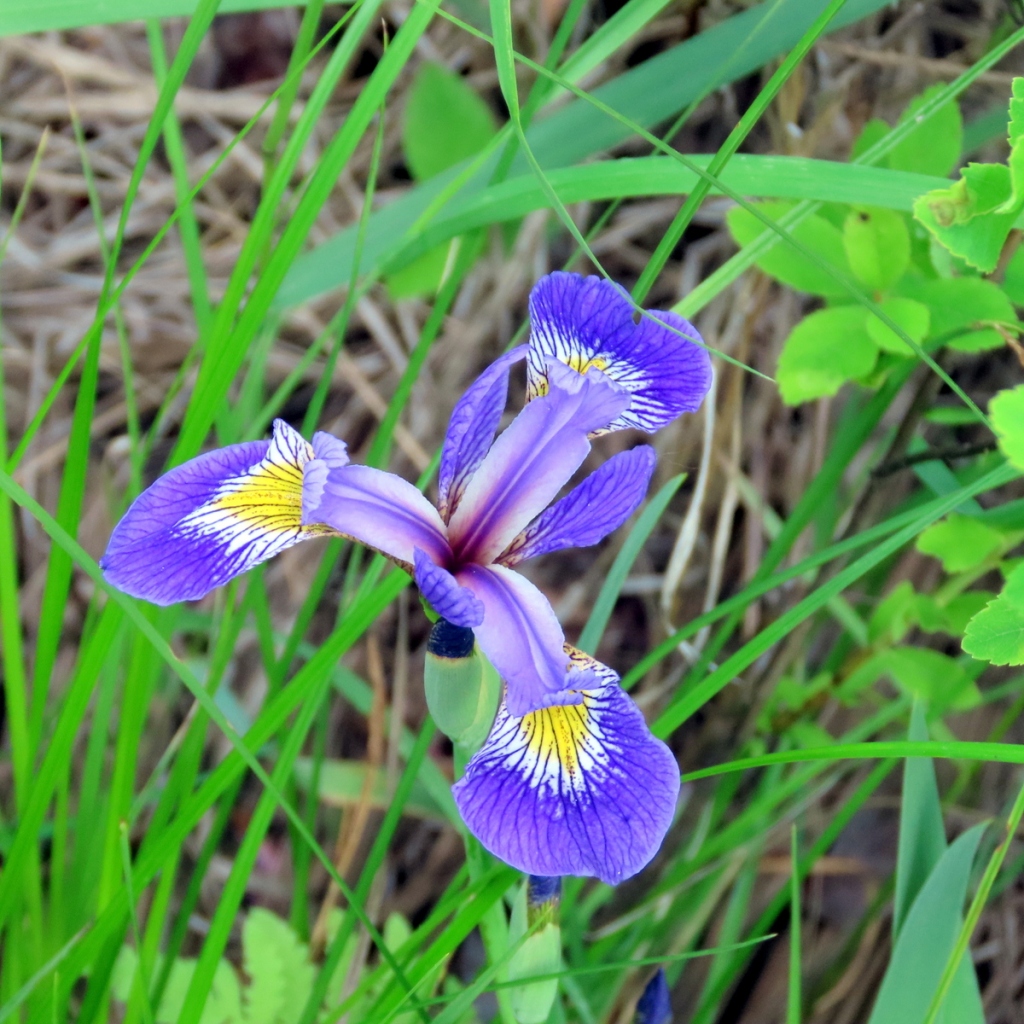
Native blue flag irises grow near the blue eyed grasses and the leaves of each plant, though very different in size, have that same blue green, sword shaped appearance. This wild iris is a sure sign that June has arrived. They usually grow in large bunches not far from water and sometimes in water. They usually grow about knee high but can get a bit taller under optimal conditions. The name “flag” comes from the Middle English flagge, which means rush or reed and which must apply to the plant’s cattail like leaves. It is said that Native Americans used the outermost fibers of the leaves to make twine.

A mother mallard was teaching her ducklings how to find food in one of the many streams found here in the wetlands. I noticed that the youngsters wore only half their adult plumage. They all swam serenely but the youngsters had better learn quickly because there are also a lot of snapping turtles here. I’ve also seen a mother wood duck with her fluffy babies but they were too quick to get a shot of. The Canada geese are also proudly showing off their goslings and the painted turtles are laying eggs, so there is a lot going on here right now.

A lot of insects are appearing now, including quite a few different butterfly species. I watched this pearl crescent land on a leaf and just sit, soaking up the sun. This is a medium size butterfly, a bit easier to see than the small, thumbnail size ones. Don’t bet the farm on my insect identification skills though because I’ve read that this butterfly is one of the hardest to identify. There are two look alike butterflies, the northern and tawny crescents, which can muddy the waters. Just call it a pretty butterfly and everything will be fine.

The little wood satyr is one of the thumbnail size butterflies. If I don’t actually see them land forget it; I just don’t see them. They have excellent camouflage and they blend in well, even with their relatively large eyespots. Though they’re said to be plentiful they’re also well hidden. I’ve read that they live on tree sap, aphid honeydew, fluids from decaying mushrooms, and, occasionally, flower nectar. I watched this one for a while and though there were many five leaved cinquefoil and bluet flowers in the area, I didn’t see it land on any of them. The caterpillar of this butterfly is said to eat grasses, so I’m sure they blend in well too.

Insects beware; there are kingbirds in the trees. Though there are also kingfishers in the trees these are not them. Eastern kingbirds eat insects, and once they get behind an insect they will follow it until they catch it, no matter what aerial maneuvers they might have to use. They’re amazingly fast and agile little birds and seem to be okay with having humans around. I’ve had them sit a few feet away from me just watching everything happen, the same as I was.
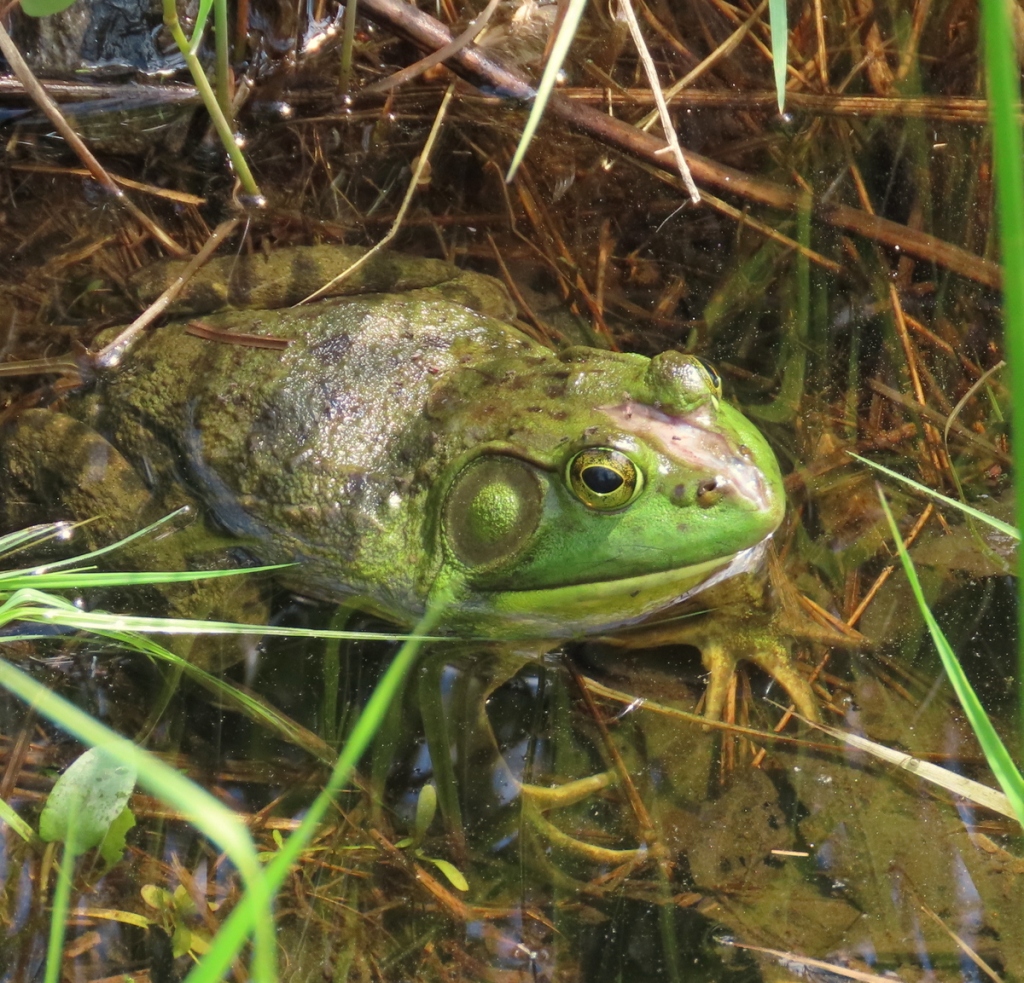
If an insect tries to get away from the kingbird by flying into the shallows they could have another surprise waiting for them; hungry bullfrogs. One evening when I was in this spot all the bullfrogs started croaking at once. It was synchronized and loud, and I could tell that there were far too many frogs here to count. And they must all have enough insects to eat.

But the frogs need to be wary as well, because they’re being hunted by American bitterns, and the bittern’s big eyes don’t miss a trick. When stretched full length as seen here they are nearly three feet tall but in their normal stalking / walking pose they’re about two feet tall. I’ve read that they take the pose seen here when they feel threatened. If the threat gets too close they fly off with the help of a three foot wingspan. And probably a belly full of frogs.
These birds are said to be rare by some but I’ve read that this is because they’re getting harder to get close to. Habitat destruction, caused by filling in wetlands, pushes them further and further away. Still, it is believed that there are only about three million of them left. Most interesting is the bird’s call, which is unlike any bird I’ve heard. Its nicknames of stake driver, bog bull, mire drum, and thunder pumper might make you want to go and hear the “voice of the marsh” online. It’s safe to sat that it is unlike anything else you’ve heard.

I’ve read that bitterns will, when the wind is blowing, sway gently back and forth to try and mimic the movement of the grasses. The stripes on its body are there to help it blend in. Though it doesn’t look it in these photos when they crouch down these birds can disappear in an instant, as if someone flipped a switch. Often only its head and bill can be seen poking up above the grasses. On the day I was taking these photos all of the sudden three of them took off and flew away from the spot where I saw only one.

But where are the dragonflies? Why aren’t they landing on the pond lily leaves?

The dragonflies aren’t landing on the pond lily leaves because they’re busy watching ants come up out of their holes in the gravel beside the road. I was amazed when I saw them doing this. They would perch on the gravel as still as a stone and when an ant came close enough they would snatch it up. Seeing this reinforces my belief that dragonflies are very intelligent creatures. I’ve seen them do some remarkable things over the years. Note how focused this one was on that ant hole a couple of inches away. Note all the ants being busy over on the right, slowly getting closer. I’ve wondered for years what dragonflies could find that was so interesting in the gravel along roadsides. Now I know.
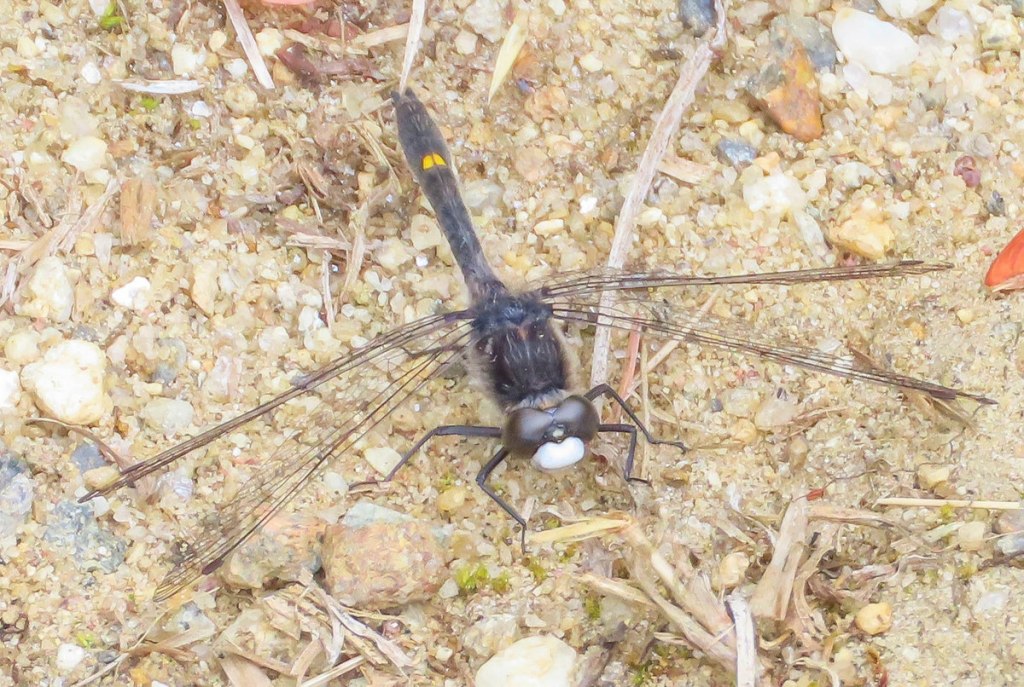
These dragonflies are called the dot-tailed whiteface. They’re on the small side at about an inch and a half long, with a black body, black legs and wings, and a white face. The “dot” part of the name comes from the yellow spot or spots on the abdomen. Males like this one have a single spot, while females can have several.

The wetlands and other spots near water are filled with nesting red winged blackbirds at the moment, and here was a fledgling sitting in the top of an alder. I was quite close to it and I expected to be assaulted by an adult male bird at any time but luckily that didn’t happen. I’m not sure if this young bird could fly because as I watched it kind of crawled / fell back into the cover of the alder. It was very vocal and loud, as most redwings always seem to be. I’ve read that females can raise as many as three broods in a season, though two seems to be about average.

Last year I was taken on a ride by the American highbush cranberry and learned how to distinguish them from invasive European cranberries. The process isn’t hard but it’s hard to explain and I don’t want to see any eyes glazing over so I’ll just say that the bushes here in the wetlands are indeed American cranberry, which aren’t cranberries at all. They are actually a native viburnum (Viburnum trilobum) which has bright red fruit that some say resemble cranberries. The trilobum part of the name comes from the three lobes found on the leaves.
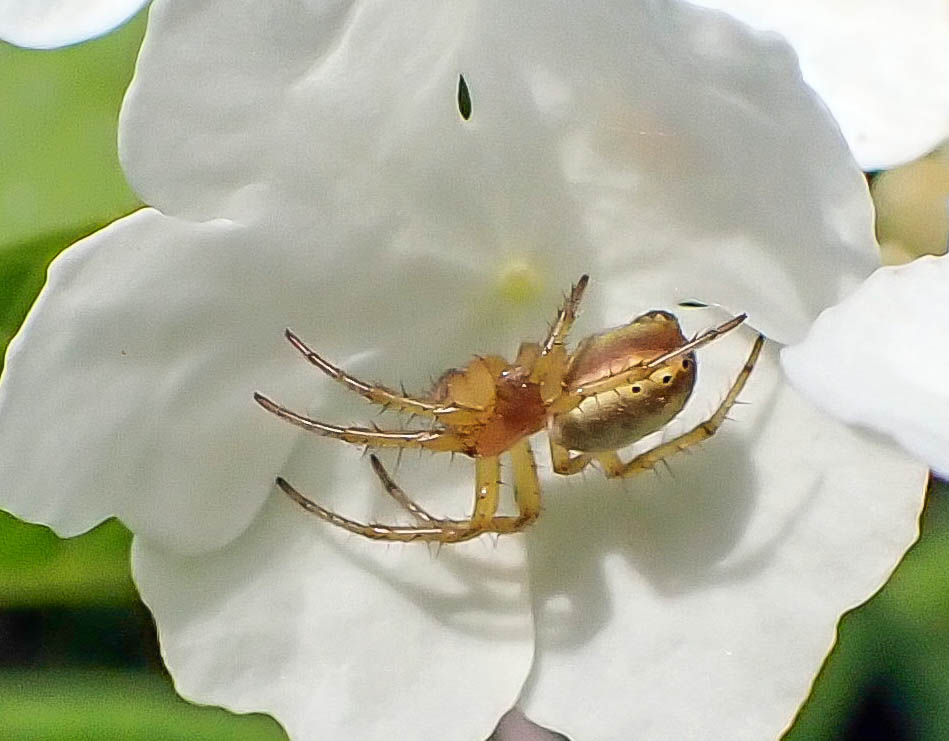
Much like our native hobblebushes which are also viburnums, highbush cranberry has large, pure white sterile flowers surrounding a center filled with much smaller true flowers. This spider knows that the larger sterile white flowers are there only to attract insects but it thought it would just hang out for a while and see what came along. Since it stood out so strongly against the bright white background I wouldn’t think it would have much chance but I’m sure it knows more about being a spider than I do, so who am I to say.
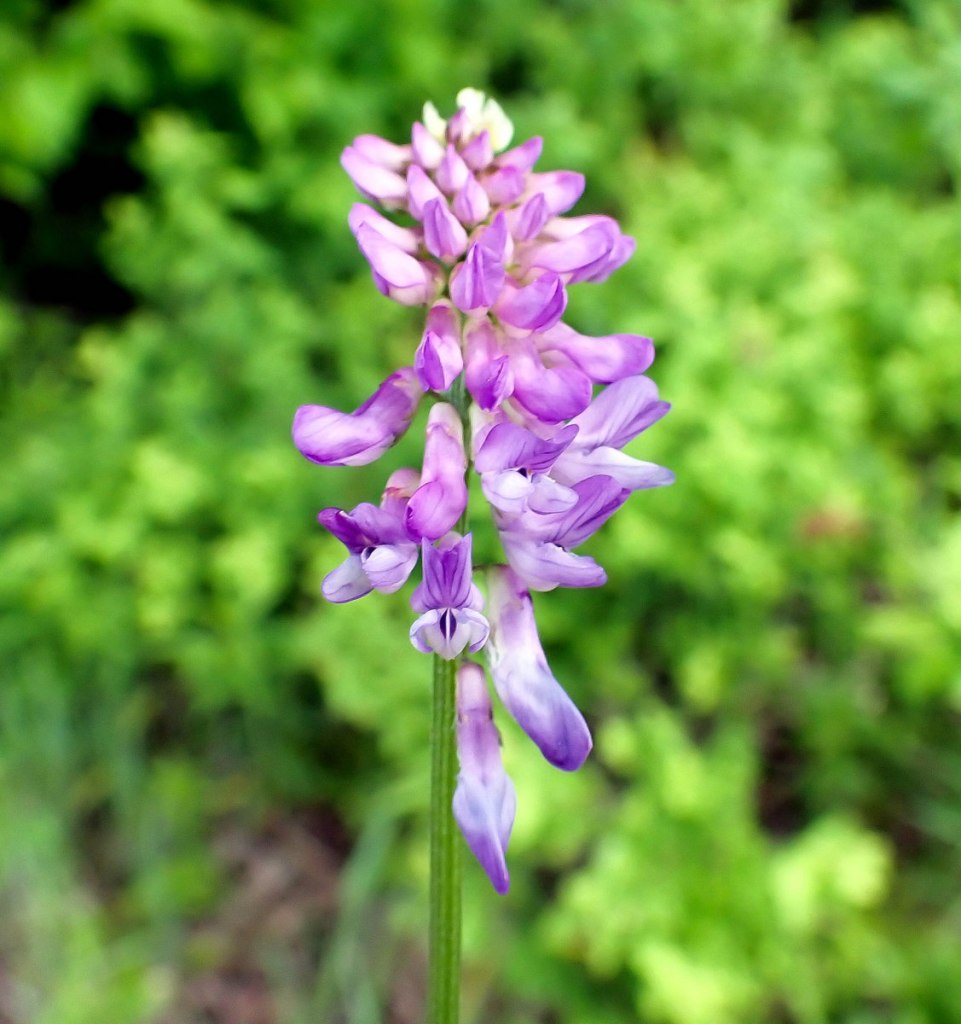
Of course not all plants in a wetland want wet feet. Vetch is a plant that likes sunny waste areas and it has just come into bloom. I like seeing it along the edges of forests and climbing high grasses, even though some see it as a pest. You might see purple but I see blue and blue is always a welcome color.

Lady’s slippers grow in the dry parts of the wetlands but you have to know where to find them. Over the years they have become a colony of maybe two dozen plants and if they are left alone and not dug up there is no reason to think that this colony won’t grow larger. The pink lady’s slipper is an orchid, and it is New Hampshire’s state flower.
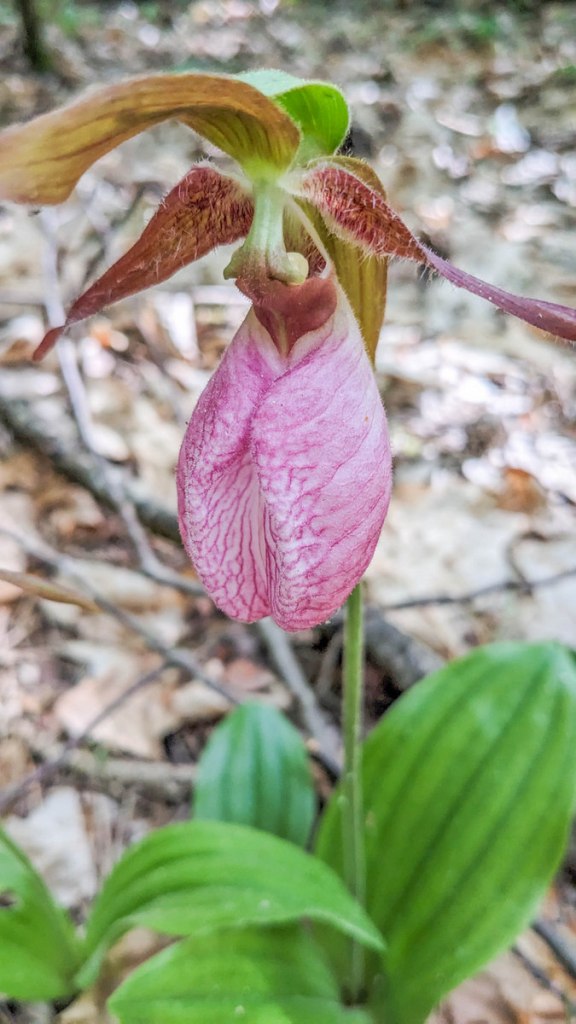
When a bumblebee forces its way through the slit in the front of the flower and crawls out the hole in the top it has most likely done its job and this flower will hopefully become a seedpod. They can take as long as eight years to grow and flower from seed.
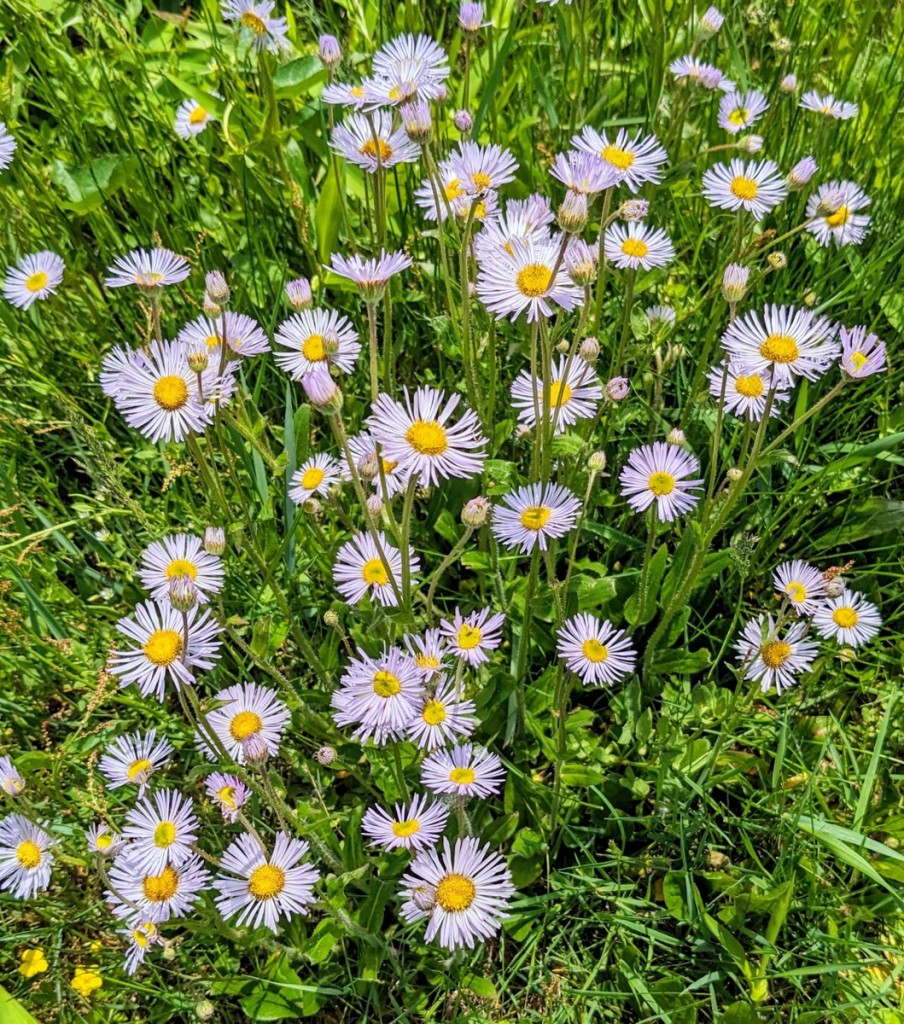
Our earliest blooming fleabane, which is called Robin’s plantain, likes dry sunny spots and it used to bloom in the drier parts of the wetlands in numbers but now they mow them down before they have a chance to bloom, so I had to go elsewhere to find them. Cemeteries are a good place to find them, I’ve discovered.

Robin’s plantain attracts many insects including butterflies like the small copper butterfly seen here. This is another of the thumbnail size butterflies but it isn’t as nervous and skittish as some others. As long as you don’t get too close it will sit still for as long as a few minutes. It has a habit of slowly opening and closing its wings as it drinks liquid sunshine from the flower.

Speaking of nervous and skittish; cabbage white butterflies were also visiting the plantain patch. These butterflies have to be really absorbed in what they’re doing before they’ll let you get close, so I’ve found if I let them land and wait until they really get into drinking that nectar, I can often sneak a little closer. Still, a zoom lens comes in handy.

I went to see a red horse chestnut tree that I know of and found it so heavy with huge bunches of flowers hanging down, I could finally get close to them. The red horse chestnut (Aesculus × carnea) is a cross between the red buckeye (Aesculus pavia) and the horse chestnut (Aesculus hippocastanum.) I’ve read that bees and hummingbirds love the beautiful red and yellow blossoms, and why wouldn’t they?

The flowers of the red horse chestnut are unusual but quite pretty. This was the first time I had ever been able to get this close to one.

While I was at the park where the red horse chestnut grows I stopped in to see my favorite tradescantia, which is named “Osprey.” It seems to have a more upright growth than the more well known blue tradescantia, and it doesn’t flop all around. I love the blue pastel shades on its petals, which can be quite pronounced as it was here, or sometimes barely noticeable on other flowers.
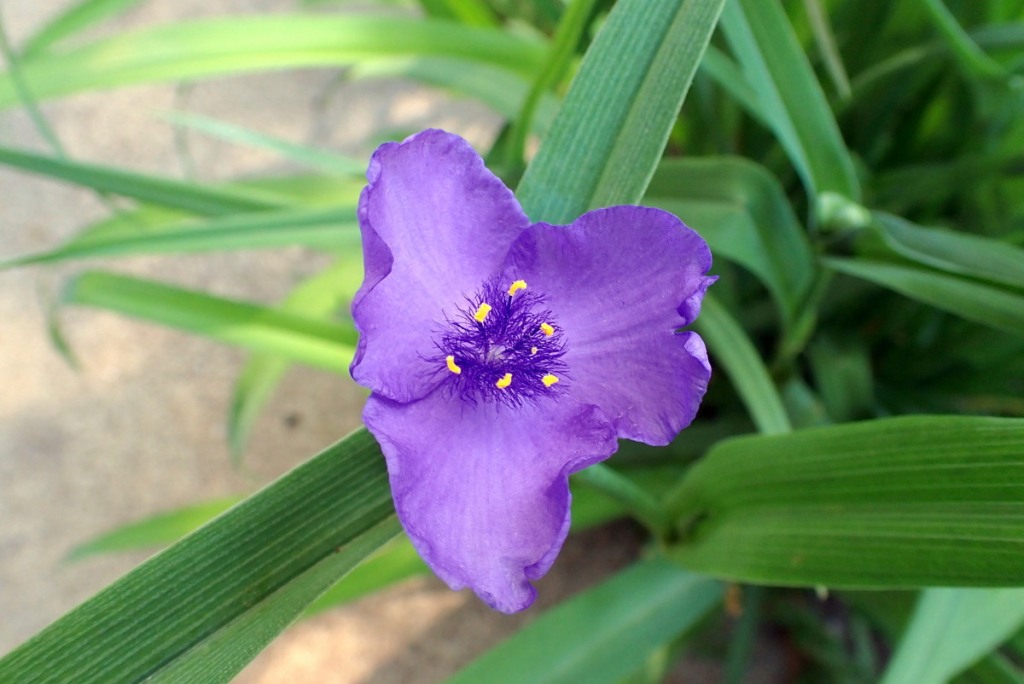
Of course I had to also stop and see my old friends the traditional blue tradescantias as well; the old spiderworts I’ve known and loved since I was a boy. I used to dig them up along the railroad tracks and take them home. My father walked along the railroad tracks to get to work so to him they were just old weeds. He never did understand what I saw in them.

I went to visit the old wisteria I know of that grows to the top of an even older black cherry tree. Last year the freeze we had in late May killed off all its buds so I wasn’t sure what I’d find this year but there it was in all its glory, flowering beautifully.

Wisteria is a legume in the pea / bean family and it’s easy to see that with a close look at the flowers. The vines will grow just about anywhere, but if planted too close to a house they can get under siding and roof shingles and tear them off, so they’re better admired from a distance. They’re beautiful when the flowers can dangle down through a pergola or other structure that can be walked through. They’re also very fragrant, so sitting outside on a warm evening watching the flowers swaying gently in the breeze and smelling their wonderful scent could be like a having a bit of the gardens seen on painted porcelain right there in your own back yard.

If you looked up the definition of serene, still, or tranquil in a dictionary and found this scene there you wouldn’t need any text. I like to spend time with the serenity I find in nature whenever I can, because it does seep into you. “What’s the hurry?” It asks, and before too long you find that you’re asking yourself the same question.
If you Love all Life you observe, you will observe all Life with Love. ~Donald L. Hicks
Thanks for stopping in.